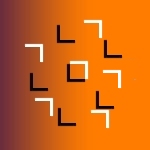
ISSN 2364-3641
Publications:
direct access:
vpl-reports.de
Open Access
| home | evaluation | archive | vpl-goettingen.de | impressum |
|
VPL-reports, 4, 1-21
The dynamics of cued visual selection (a particular manifestation of "focal attention") were studied in multiple
line arrays in which one element (the target to be identified) was marked by a cue; presentation time after cue
application was varied. Aim of these experiments was to compare the dynamics of direct and indirect cueing in
visual selection and to investigate the influence of spatial parameters, in particular the cue-target distance and
the figural connectedness of cue and target locations, on speed and efficiency of the selection process.
Performance in direct cueing slowed down with the distance between cue and target (Exp. 1), thus approaching the
generally slower dynamics of indirect selection (Exp. 2). This slow-down did not occur when the target location
was known beforehand (Exp. 3). Performance was also delayed at small cue-target distances, at which cues
interfered with the target both when the target location was known and unknown. In Experiment 4, the tests were
repeated with figure-like items in which targets and cues were connected by tentacles. Also in these patterns
near cues led to faster performance than far cues. An advantage of the figural connectedness was only seen with
distant and ambiguous cue locations where tentacles helped to link cues to the correct bar. Altogether, the data
document the importance of cue parameters when single targets must be quickly selected from a large sample.
|
Download pdf ppt of figures Comments: |
©